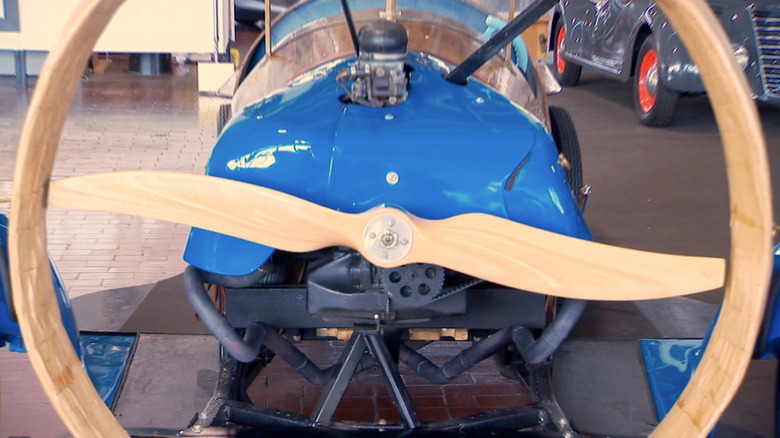This Bizarre Propeller-Powered Car Is Still Driving After Almost A Century
The evolution of the automobile has been one of the more fascinating happenings of the modern era. If you're at all familiar with the history of cars, you know the line from the earliest models to more modern builds is a relatively straight one. Over the years, there have, of course, been some pretty radical deviations from the more classic design elements of the automobile. Few of those deviations were quite as radical as a propeller-powered car from 1932.
This car was never a proper production vehicle, nor was it one of those wild concept cars we've so often seen in sketches and renderings from the major automobile manufacturers. Rather, this vehicle appears to be designed or at least inspired by a French engineer named Marcel Leyat. The Frenchman was primarily concerned with aviation in the early days of his design work, reportedly building and flying his own aircraft sometime in the early 1900s.
Somewhere along the line, Leyat became convinced that the propeller design that helped his planes fly could do the same for automobiles. Turns out, he designed and built several propeller-powered cars. His first one, the Helico, was built in 1919. Funnily enough, another propeller-powered vehicle called the Helicron thought to have been built in 1932 was also discovered years later. Although it's origins are unknown, its similarities to Leyat's Helico model — starting with the name itself — suggest it could have been another one of Leyat's designs, or that of some other auto enthusiast who was inspired by him. Nevertheless, a fellow engineer is still cruising around town in the gonzo auto creation nearly a century later. He is, however, doing so far from France.
Where you can see the one-of-a-kind '32 Helicron for yourself
Whoever the designer of this Helicron was, they appeared to have constructed it by dramatically modifying the chassis of an Austin 7, which was once a favorite vehicle of Mr. Mick Fleetwood. They made the back of that chassis the front of the vehicle so that the Helicron was steered by the rear wheels, which makes sense as that's also how most aeronautical vehicles of that era were controlled. The body of the car was largely made of wood, and the vehicle needed neither a clutch or transmission to operate.
There is also a massive wood propeller attached to the front, which — combined with a Citron GS 1.3L 4-cylinder engine — actually does provide enough power to get the Helicron going to a potential high speed of about 50 miles per hour. Acceleration is not the Helicron's strong suit, however, so it could take some time to get there. That engine is not original, for the record. It would seem that the current propeller is not original either, with the Helicron's current caretakers admitting that they added a new one after finding it.
As for the Helicron's current tenders, that honor has fallen to the owners of the Lane Motor Museum in Nashville, Tennessee. This museum houses it among its permanent collection of rare and antique automobiles. The vehicle has been there for some time now, having been discovered in 2000 almost entirely buried by rubble in a French barn, where it had been stowed away since the late-1930s.

